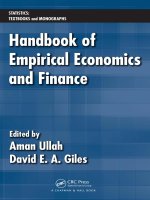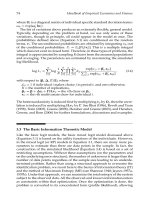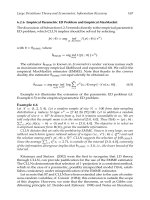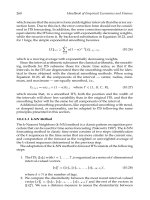Handbook of LABOR ECONOMICS volume 4a 2010
Bạn đang xem bản rút gọn của tài liệu. Xem và tải ngay bản đầy đủ của tài liệu tại đây (6.42 MB, 862 trang )
Handbook of
LABOR ECONOMICS
VOLUME
4A
INTRODUCTION TO THE SERIES
The aim of the Handbooks in Economics series is to produce Handbooks for various
branches of economics, each of which is a definitive source, reference, and teaching
supplement for use by professional researchers and advanced graduate students. Each
Handbook provides self-contained surveys of the current state of a branch of economics
in the form of chapters prepared by leading specialists on various aspects of this
branch of economics. These surveys summarize not only received results but also newer
developments, from recent journal articles and discussion papers. Some original material
is also included, but the main goal is to provide comprehensive and accessible surveys.
The Handbooks are intended to provide not only useful reference volumes for
professional collections but also possible supplementary readings for advanced courses
for graduate students in economics.
KENNETH J. ARROW and MICHAEL D. INTRILIGATOR
Handbook of
LABOR ECONOMICS
VOLUME
4A
Edited by
ORLEY ASHENFELTER
DAVID CARD
·
·
·
·
·
·
·
Amsterdam Boston Heidelberg London New York Oxford
Paris San Diego San Francisco Singapore Sydney Tokyo
·
·
·
North Holland is an imprint of Elsevier
North Holland is an imprint of Elsevier
525 B Street, Suite 1800, San Diego, CA 92101-4495, USA
Radarweg 29, 1000 AE Amsterdam, The Netherlands
First edition 2011
Copyright c 2011 Elsevier B.V. All rights reserved
No part of this publication may be reproduced, stored in a retrieval system or transmitted in any form or by
any means electronic, mechanical, photocopying, recording or otherwise without the prior written
permission of the publisher
Permissions may be sought directly from Elsevier’s Science & Technology Rights Department in Oxford,
UK: phone (+44) (0) 1865 843830; fax (+44) (0) 1865 853333; email:
Alternatively you can submit your request online by visiting the Elsevier web site at
and selecting Obtaining permission to use Elsevier material
Notice
No responsibility is assumed by the publisher for any injury and/or damage to persons or property as a
matter of products liability, negligence or otherwise, or from any use or operation of any methods, products,
instructions or ideas contained in the material herein. Because of rapid advances in the medical sciences, in
particular, independent verification of diagnoses and drug dosages should be made
Library of Congress Cataloging-in-Publication Data
A catalog record for this book is available from the Library of Congress
British Library Cataloguing in Publication Data
A catalogue record for this book is available from the British Library
ISBN 4A: 978-0-44-453450-7
ISBN 4B: 978-0-44-453452-1
Set ISBN: 978-0-44-453468-2
For information on all North Holland publications
visit our web site at elsevierdirect.com
Printed and bound in Great Britain
11 12 13 14 10 9 8 7 6 5 4 3 2 1
CONTENTS OF VOLUME 4A
Contents of Volume 4B
Contributors to Volume 4A
1. Decomposition Methods in Economics
ix
xiii
1
Nicole Fortin, Thomas Lemieux, Sergio Firpo
1. Introduction
2. Identification: What Can We Estimate Using Decomposition Methods?
3. Oaxaca-Blinder—Decompositions of Mean Wages Differentials
4. Going beyond the Mean—Distributional Methods
5. Detailed Decompositions for General Distributional Statistics
6. Extensions
7. Conclusion
References
2. Field Experiments in Labor Economics
2
13
36
52
74
87
96
97
103
John A. List, Imran Rasul
1. Introduction
2. Human Capital
3. Labor Market Discrimination
4. Firms
5. Households
6. Concluding Remarks
References
3. Lab Labor: What Can Labor Economists Learn from the Lab?
104
140
149
177
208
213
213
229
Gary Charness, Peter Kuhn
1. Why Laboratory Experiments?
2. Issues in Designing Laboratory Experiments
3. Testing ‘‘Traditional’’ Principal-Agent Theory in the Lab
4. Towards Behavioral Principal-Agent Theory: Fairness, Social Preferences and Effort
5. More Lab Labor: Bargaining, Search, Markets, and Discrimination
6. Conclusions
References
231
238
246
276
294
312
315
v
vi
Contents of Volume 4A
4. The Structural Estimation of Behavioral Models: Discrete Choice Dynamic
Programming Methods and Applications
331
Michael P. Keane, Petra E. Todd, Kenneth I. Wolpin
1. Introduction
2. The Latent Variable Framework for Discrete Choice Problems
3. The Common Empirical Structure of Static and Dynamic Discrete Choice Models
4. Applications
5. Concluding Remarks—How Credible are DCDP Models?
References
5. Program Evaluation and Research Designs
332
335
336
371
452
455
463
John DiNardo, David S. Lee
1. Introduction
2. Scope and Background
3. Research Designs Dominated by Knowledge of the Assignment Process
4. Research Designs Dominated by Self-Selection
5. Program Evaluation: Lessons and Challenges
References
6. Identification of Models of the Labor Market
464
468
480
516
529
532
537
Eric French, Christopher Taber
1. Introduction
2. Econometric Preliminaries
3. The Roy Model
4. The Generalized Roy Model
5. Treatment Effects
6. Duration Models and Search Models
7. Forward looking dynamic models
8. Conclusions
Technical Appendix
References
7. Search in Macroeconomic Models of the Labor Market
538
539
545
560
567
591
599
609
609
614
619
Richard Rogerson, Robert Shimer
1. Cyclical Fluctuations
2. Trends
3. Conclusion
References
623
663
691
694
Contents of Volume 4A
8. Extrinsic Rewards and Intrinsic Motives: Standard and Behavioral Approaches
to Agency and Labor Markets
701
James B. Rebitzer, Lowell J. Taylor
1. Introduction
2. Agency and Extrinsic Rewards
3. Extrinsic rewards and dual-purpose incentives
4. Behavioral approaches to agency and motivation
5. Dual-Purpose incentives: can pay destroy intrinsic motivation?
6. Conclusions
References
Subject Index to Volume 4A
Subject Index to Volume 4B
702
705
721
727
747
764
766
xv
xlix
vii
This page intentionally left blank
CONTENTS OF VOLUME 4B
Contents of Volume 4A
Contributors to Volume 4B
xcvii
ci
9. Earnings, Consumption and Life Cycle Choices
773
Costas Meghir, Luigi Pistaferri
1. Introduction
2. The Impact of Income Changes on Consumption: Some Theory
3. Modeling the Income Process
4. Using Choices to Learn About Risk
5. Income Processes, Labor Supply and Mobility
6. Conclusions
References
10. Racial Inequality in the 21st Century: The Declining Significance of
Discrimination
774
779
789
818
839
846
848
855
Roland G. Fryer Jr.
1. Introduction
2. The Declining Significance of Discrimination
3. Basic Facts About Racial Differences in Achievement Before Kids Enter School
4. Interventions to Foster Human Capital Before Children Enter School
5. The Racial Achievement Gap in Kindergarten through 12th Grade
6. The Racial Achievement Gap in High School
7. Interventions to Foster Human Capital in School-Aged Children
8. Conclusion
Appendix. Data Description
References
11. Imperfect Competition in the Labor Market
856
858
865
874
880
907
912
925
926
965
973
Alan Manning
1.
2.
3.
4.
5.
6.
The Sources of Imperfect Competition
How Much Imperfect Competition? The Size of Rents
Models of Wage Determination
Estimates of Rent-splitting
So What?
Applications
976
980
990
997
1021
1022
ix
x
Contents of Volume 4B
7. Conclusion
1031
Appendix A. Estimating the Size of Rents from a Search Model
1031
Appendix B. A Model with Heterogeneous Worker Ability
1032
Appendix C. Results Equating Separation and Recruitment Elasticity
1034
References
1035
12. Skills, Tasks and Technologies: Implications for Employment and Earnings
1043
Daron Acemoglu, David Autor
1. Introduction
1044
2. An Overview of Labor Market Trends
1048
3. The Canonical Model
1096
4. A Ricardian Model of the Labor Market
1118
5. Comparative Advantage and Wages: An Empirical Approach
1152
6. Concluding remarks
1157
References
1166
13. Institutional Reforms and Dualism in European Labor Markets
1173
Tito Boeri
1. Introduction
1174
2. Institutions and Reforms
1176
3. A Simple Model of Labor Reallocation and Reforms
1190
4. Are We Learning Enough from the Reforms?
1208
5. Final Remarks
1222
Appendix A. The fRDB-IZA Social Policy Reforms Database
1223
Appendix B. Institutions in the MP Model
1224
References
1232
14. Local Labor Markets
1237
Enrico Moretti
1. Introduction
1238
2. Some Important Facts about Local Labor Markets
1242
3. Equilibrium in Local Labor Markets
1254
4. The Determinants of Productivity Differences Across Local Labor Markets
1281
5. Implications for Policy
1296
6. Conclusions
1308
References
1309
Contents of Volume 4B
15. Human Capital Development before Age Five
1315
Douglas Almond, Janet Currie
1. Introduction
2. Conceptual Framework
3. Methods
4. Empirical Literature: Evidence of Long Term Consequences
5. Empirical Literature: Policy Responses
6. Discussion and Conclusions
Appendix A
Appendix B
Appendix C
Appendix D
References
16. Recent Developments in Intergenerational Mobility
1316
1322
1328
1340
1396
1467
1468
1471
1472
1475
1476
1487
Sandra E. Black, Paul J. Devereux
1. Intergenerational Correlations of Earnings and Education
2. Identifying the Causal Effects of Parental Education and Earnings
3. Other Family Background Characteristics
4. Conclusion
References
17. New Perspectives on Gender
1489
1507
1528
1533
1534
1543
Marianne Bertrand
1. Introduction
2. Gender Differences in Psychological Attributes
3. Gender Identity
4. Women’s Well-being
5. Conclusion
References
18. Great Expectations: Law, Employment Contracts, and Labor Market
Performance
1544
1546
1570
1577
1580
1582
1591
W. Bentley MacLeod
1. Introduction
2. The Law
3. The Economics of the Employment Relationship
4. The Evidence
5. Discussion
References
1592
1596
1616
1643
1685
1688
xi
xii
Contents of Volume 4B
19. Human Resource Management and Productivity
1697
Nicholas Bloom, John Van Reenen
1. Introduction
2. Some Facts on HRM and Productivity
3. The Effects of HRM on Productivity
4. Two Perspectives on HRM and Productivity: Design and Technology
5. Some Determinants of HRM Practices
6. Conclusions
Acknowledgements
References
20. Personnel Economics: Hiring and Incentives
1698
1699
1710
1739
1745
1757
1759
1759
1769
Paul Oyer, Scott Schaefer
1. Introduction
2. Incentives in Organizations
3. Hiring
4. Conclusion
References
Subject Index to Volume 4B
Subject Index to Volume 4A
1770
1772
1784
1816
1817
ciii
cxliii
CONTRIBUTORS TO VOLUME 4A
Nicole Fortin
UBC and CIFAR
Thomas Lemieux
UBC and NBER
Sergio Firpo
EESP-FGV and IZA
John A. List
Department of Economics, University of Chicago, 1126 East 59th Street, Chicago,
IL 60637, USA
Imran Rasul
Department of Economics, University College London, Drayton House, 30 Gordon Street,
London WC1E 6BT, United Kingdom
Gary Charness
University of California, Santa Barbara, United States
Peter Kuhn
University of California, Santa Barbara, United States
Michael P. Keane
University of Technology, Sydney and Arizona State University
Petra E. Todd
University of Pennsylvania
Kenneth I. Wolpin
University of Pennsylvania
John DiNardo
University of Michigan and NBER
David S. Lee
Princeton University and NBER
Eric French
Federal Reserve Bank of Chicago
Christopher Taber
Department of Economics, University of Wisconsin-Madison and NBER
Richard Rogerson
Arizona State University, United States
xiii
xiv
Contributors to Volume 4A
Robert Shimer
University of Chicago, United States
James B. Rebitzer
Boston University and NBER
Lowell J. Taylor
Carnegie Mellon University
This page intentionally left blank
CHAPTER
1
Decomposition Methods in Economics
Nicole Fortin * , Thomas Lemieux ** , Sergio Firpo ***
* UBC and CIFAR
** UBC and NBER
*** EESP-FGV and IZA
Contents
1. Introduction
2. Identification: What Can We Estimate Using Decomposition Methods?
2.1. Case 1: The aggregate decomposition
2.1.1.
2.1.2.
2.1.3.
2.1.4.
2.1.5.
2.1.6.
The overall wage gap and the structural form
Four decomposition terms
Imposing identification restrictions: overlapping support
Imposing identification restrictions: ignorability
Identification of the aggregate decomposition
Why ignorability may not hold, and what to do about it
2.2. Case 2: The detailed decomposition
14
17
17
18
21
24
25
2.2.1. Nonparametric identification of structural functions
2.2.2. Functional form restrictions: decomposition of the mean
2.2.3. Functional form restrictions: more general decompositions
2.3. Decomposition terms and their relation to causality and the treatment effects literature
3. Oaxaca-Blinder—Decompositions of Mean Wages Differentials
3.1. Basics
3.2. Issues with detailed decompositions: choice of the omitted group
3.3. Alternative choices of counterfactual
3.4. Reweighted-regression decompositions
3.5. Extensions to limited dependent variable models
3.6. Statistical inference
4. Going beyond the Mean—Distributional Methods
4.1. Variance decompositions
4.2. Going beyond the variance: general framework
4.3. Residual imputation approach: JMP
4.4. Methods based on conditional quantiles
4.5. Reweighting methods
4.6. Methods based on estimating the conditional distribution
4.7. Summary
5. Detailed Decompositions for General Distributional Statistics
5.1. Methods based on the conditional distribution
5.2. RIF-regression methods
5.3. A reweighting approach
5.4. Detailed decomposition based on conditional quantiles
Handbook of Labor Economics, Volume 4a
c 2010 Elsevier B.V.
2
13
14
27
29
29
33
36
36
43
47
48
51
52
52
54
56
58
60
63
69
74
74
75
76
82
87
ISSN 0169-7218, DOI 10.1016/S0169-7218(11)00407-2
All rights reserved.
1
2
Nicole Fortin et al.
6. Extensions
6.1. Dealing with self-selection and endogeneity
6.2. Panel data
6.3. Decomposition in structural models
7. Conclusion
References
87
88
91
92
96
97
Abstract
This chapter provides a comprehensive overview of decomposition methods that have been
developed since the seminal work of Oaxaca and Blinder in the early 1970s. These methods are used
to decompose the difference in a distributional statistic between two groups, or its change over time,
into various explanatory factors. While the original work of Oaxaca and Blinder considered the case
of the mean, our main focus is on other distributional statistics besides the mean, such as quantiles,
the Gini coefficient or the variance. We discuss the assumptions required for identifying the different
elements of the decomposition, as well as various estimation methods proposed in the literature. We
also illustrate how these methods work in practice by discussing existing applications and working
through a set of empirical examples throughout the paper.
JEL classification: J31; J71; C14; C21
Keywords: Decomposition; Counterfactual distribution; Inequality; Wage structure; Wage differentials;
Discrimination
1. INTRODUCTION
What are the most important explanations accounting for pay differences between men
and women? To what extent has wage inequality increased in the United States between
1980 and 2010 because of increasing returns to skill? Which factors are behind most
of the growth in US GDP over the last 100 years? These important questions all share
a common feature. They are typically answered using decomposition methods. The
growth accounting approach pioneered by Solow (1957) and others is an early example
of a decomposition approach aimed at quantifying the contribution of labor, capital,
and unexplained factors (productivity) to US growth.1 But it is in labor economics,
starting with the seminal papers of Oaxaca (1973) and Blinder (1973), that decomposition
methods have been used the most extensively. These two papers are among the most
heavily cited in labor economics, and the Oaxaca-Blinder (OB) decomposition is now a
standard tool in the toolkit of applied economists. A large number of methodological
papers aimed at refining the OB decomposition, and expanding it to the case of
distributional parameters besides the mean, have also been written over the past three
decades.
The twin goals of this chapter are to provide a comprehensive overview of
decomposition methods that have been developed since the seminal work of Oaxaca and
1 See also Kendrick (1961), Denison (1962), and Jorgenson and Griliches (1967).
Decomposition Methods in Economics
Blinder, and to suggest a list of best practices for researchers interested in applying these
methods.2 We also illustrate how these methods work in practice by discussing existing
applications and working through a set of empirical examples throughout the chapter.
At the outset, it is important to note a number of limitations to decomposition
methods that are beyond the scope of this chapter. As the above examples show, the
goal of decomposition methods are often quite ambitious, which means that strong
assumptions typically underlie these types of exercises. In particular, decomposition
methods inherently follow a partial equilibrium approach. Take, for instance, the
question “what would happen to average wages in the absence of unions?”As H. Gregg
Lewis pointed out a long time ago (Lewis, 1963, 1986), there are many reasons to believe
that eliminating unions would change not only the wages of union workers, but also those
of non-union workers. In this setting, the observed wage structure in the non-union
sector would not represent a proper counterfactual for the wages observed in the absence
of unions. We discuss these general equilibrium considerations in more detail towards the
end of the paper, but generally follow the standard partial equilibrium approach where
observed outcomes for one group (or region/time period) can be used to construct
various counterfactual scenarios for the other group.
A second important limitation is that while decompositions are useful for quantifying
the contribution of various factors to a difference or change in outcomes in an accounting
sense, they may not necessarily deepen our understanding of the mechanisms underlying
the relationship between factors and outcomes. In that sense, decomposition methods,
just like program evaluation methods, do not seek to recover behavioral relationships
or “deep” structural parameters. By indicating which factors are quantitatively
important and which are not, however, decompositions provide useful indications of
particular hypotheses or explanations to be explored in more detail. For example, if a
decomposition indicates that differences in occupational affiliation account for a large
fraction of the gender wage gap, this suggests exploring in more detail how men and
women choose their fields of study and occupations.
Another common use of decompositions is to provide some “bottom line” numbers
showing the quantitative importance of particular empirical estimates obtained in a study.
For example, while studies after studies show large and statistically significant returns
to education, formal decompositions indicate that only a small fraction of US growth,
or cross-country differences, in GDP per capita can be accounted for by changes or
differences in educational achievement.
2 We limit our discussion to so-called “regression-based” decomposition methods, where the decomposition focuses
on explanatory factors, rather than decomposition methods that apply to additively decomposable indices, where the
decomposition pertains to population sub-groups. Bourguignon and Ferreira (2005) and Bourguignon et al. (2008) are
recent surveys discussing these methods.
3
4
Nicole Fortin et al.
Main themes and road map to the chapter
The original method proposed by Oaxaca and Blinder for decomposing changes or
differences in the mean of an outcome variable has been considerably improved and
expanded upon over the years. Arguably, the most important development has been to
extend decomposition methods to distributional parameters other than the mean. For
instance, Freeman (1980, 1984) went beyond a simple decomposition of the difference
in mean wages between the union and non-union sector to look at the difference in the
variance of wages between the two sectors.
But it is the dramatic increase in wage inequality observed in the United States and
several other countries since the late 1970s that has been the main driving force behind
the development of a new set of decomposition methods. In particular, the new methods
introduced by Juhn et al. (1993) and DiNardo et al. (1996) were directly motivated by an
attempt at better understanding the underlying factors behind inequality growth. Going
beyond the mean introduces a number of important econometric challenges and is still
an active area of research. As a result, we spend a significant portion of the chapter on
these issues.
A second important development has been to use various tools from the program
evaluation literature to (i) clarify the assumptions underneath popular decomposition
methods, (ii) propose estimators for some of the elements of the decomposition, and (iii)
obtain formal results on the statistical properties of the various decomposition terms. As
we explain below, the key connection with the treatment effects literature is that the
“unexplained” component of a Oaxaca decomposition can be interpreted as a treatment
effect. Note that, despite the interesting parallel with the program evaluation literature,
we explain in the paper that we cannot generally give a “causal” interpretation to the
decomposition results.
The chapter also covers a number of other practical issues that often arise when
working with decomposition methods. Those include the well known omitted group
problem (Oaxaca and Ransom, 1999), and how to deal with cases where we suspect the
true regression equation not to be linear.
Before getting into the details of the chapter, we provide here an overview of our
main contributions by relating them to the original OB decomposition for the difference
in mean outcomes for two groups A and B. The standard assumption used in these
decompositions is that the outcome variable Y is linearly related to the covariates, X ,
and that the error term υ is conditionally independent of X :
K
Ygi = βg0 +
X ik βgk + υgi ,
k=1
g = A, B,
(1)
Decomposition Methods in Economics
where E(υgi |X i ) = 0, and X is the vector of covariates (X i = [X i1 , . . . , X i K ]). As is
well known, the overall difference in average outcomes between group B and A,
µ
O
= Y B − Y A,
can be written as:3
K
K
µ
O
=
(β B0 − β A0 ) +
X Bk β Bk − β Ak
+
k=1
µ
S
X Bk − X Ak β Ak
k=1
µ
X
(Unexplained)
(Explained)
where βg0 and βgk (k = 1, . . . , K ) are the estimated intercept and slope coefficients,
respectively, of the regression models for groups g = A, B. The first term in the
equation is what is usually called the “unexplained” effect in Oaxaca decompositions.
Since we mostly focus on wage decompositions in this chapter, we typically refer to
µ
µ
this first element as the “wage structure” effect ( S ). The second component, X ,
is a composition effect, which is also called the “explained” effect (by differences in
covariates) in OB decompositions.
In the above decomposition, it is straightforward to compute both the overall
composition and wage structure effects, and the contribution of each covariate to
these two effects. Following the existing literature on decompositions, we refer to
µ
µ
µ
the overall decomposition (separating O in its two components S and X ) as an
µ
aggregate decomposition. The detailed decomposition involves subdividing both S , the wage
µ
structure effect, and X , the composition effect, into the respective contributions of each
µ
µ
covariate, S,k and X,k , for k = 1, . . . , K .
The chapter is organized around the following “take away” messages:
3 The decomposition can also be written by exchanging the reference group used for the wage structure and composition
effects as follows:
µ
O =
K
K
(β B0 − β A0 ) +
X Ak β Bk − β Ak
k=1
X Bk − X Ak β Bk .
+
k=1
Alternatively, the so-called three-fold decomposition uses the same reference group for both effects, but introduces
a third interaction term:
K
k=1 X Bk − X Ak
µ
O =
(β B0 − β A0 ) +
K
k=1 X Ak β Bk − β Ak
+
K
k=1 X Bk − X Ak β Ak
+
β Bk − β Ak . While these various versions of the basic decomposition are used in the
literature, using one or the other does not involve any specific estimation issues. For the sake of simplicity, we thus
focus on the one decomposition introduced in the text for most of the chapter.
5
6
Nicole Fortin et al.
A. The wage structure effect can be interpreted as a treatment effect
This point is easily seen in the case where group B consists of union workers, and group
A consists of non-union workers. The raw wage gap µ can be decomposed as the sum
µ
of the “effect” of unions on union workers, S , and the composition effect linked to
µ
differences in covariates between union and non-union workers, X . We can think of
the effect of unions for each worker (Y Bi − Y Ai ) as the individual treatment effect, while
µ
S is the Average Treatment effect on the Treated (ATT). One difference between the
µ
program evaluation and decomposition approaches is that the composition effect X
is a key component of interest in a decomposition, while it is a selection bias resulting
from a confounding factor to be controlled for in the program evaluation literature.
By construction, however, one can obtain the composition effect from the estimated
µ
µ
µ
µ
treatment effect since ATT = S and X = O − S .
Beyond semantics, there are a number of advantages associated with representing the
µ
decomposition component S as a treatment effect:
• The zero conditional mean assumption (E(υ|X ) = 0) usually invoked in OB
decompositions (as above) is not required for consistently estimating the ATT (or
µ
S ). The mean independence assumption can be replaced by a weaker ignorability
assumption. Under ignorability, unobservables do not need to be independent (or
mean independent) of X as long as their conditional distribution given X is the same
in groups A and B. In looser terms, this “selection based on observables” assumption
allows for selection biases as long they are the same for the two groups. For example,
if unobservable ability and education are correlated, a linear regression of Y on X will
not yield consistent estimates of the structural parameters (i.e. the return to education).
But the aggregate decomposition remains valid as long as the dependence structure
between ability and education is the same in group A and B.
• A number of estimators for the ATT have been proposed in the program evaluation
literature including Inverse Probability Weighting (IPW), matching and regression
µ
methods. Under ignorability, these estimators are consistent for the ATT (or S )
even if the relationship between Y and X is not linear. The statistical properties
of these non-parametric estimators are also relatively well established. For example,
Hirano et al. (2003) show that IPW estimators of the ATT are efficient. Firpo
(2007) similarly shows that IPW is efficient for estimating quantile treatment effects.
Accordingly, we can use the results from the program evaluation literature to show that
decomposition methods based on reweighting techniques are efficient for performing
decompositions.4
4 Firpo (2010) shows that for any smooth functional of the reweighted cdf, efficiency is achieved. In other words,
decomposing standard distributional statistics such as the variance, the Gini coefficient, or the interquartile range using
the reweighting method suggested by DiNardo et al. (1996) will be efficient. Note, however, that this result does
not apply to the (more complicated) case of the density considered by DiNardo et al. (1996) where non-parametric
estimation is involved.
Decomposition Methods in Economics
• When the distribution of covariates is different across groups, the ATT depends on
the characteristics of group B (unless there is no heterogeneity in the treatment effect,
µ
i.e. β Bk = β Ak for all k). The subcomponents of S associated with each covariate k,
X Bk (β Bk − β Ak ), can be (loosely) interpreted as the “contribution” of the covariate k
to the ATT. This helps understand the issues linked to the well-known “omitted group
problem” in OB decompositions (see, for example Oaxaca and Ransom, 1999).
B. Going beyond the mean is a ‘‘solved’’ problem for the aggregate decomposition
As discussed above, estimation methods from the program evaluation literature can be
µ
directly applied for performing an aggregate decomposition of the gap O into its two
µ
µ
components S and X . While most of the results in the program evaluation literature
have been obtained in the case of the mean (e.g., Hirano et al., 2003), they can also be
extended to the case of quantiles (Firpo, 2007) or more general distribution parameters
(Firpo, 2010). The IPW estimator originally proposed in the decomposition literature by
DiNardo et al. (1996) or matching methods can be used to perform the decomposition
under the assumption of ignorability. More parametric approaches such as those proposed
by Juhn et al. (1993), Donald et al. (2000) and Machado and Mata (2005) could also be
used. These methods involve, however, a number of assumptions and/or computational
difficulties that can be avoided when the sole goal of the exercise is to perform an
aggregate decomposition. By contrast, IPW methods involve no parametric assumptions
and are an efficient way of estimating the aggregate decomposition.
It may be somewhat of an overstatement to say that computing the aggregate
decomposition is a “solved” problem since there is still ongoing research on the small
sample properties of various treatment effect estimators (see, for example, Busso et al.,
2009). Nonetheless, performing an aggregate decomposition is relatively straightforward
since several easily implementable estimators with good asymptotics properties are
available.
C. Going beyond the mean is more difficult for the detailed decomposition
Until recently, no comprehensive approach was available for computing a detailed
decomposition of the effect of single covariates for a distributional statistic ν other
than the mean. One popular approach for estimating the subcomponents of νS is
Machado and Mata (2005)’s method, which relies on quantile regressions for each
possible quantile, combined with a simulation procedure. For the subcomponents of νX ,
DiNardo et al. (1996) suggest a reweighting procedure to compute the contribution
of a dummy covariate (like union status) to the aggregate composition effect νX .
Altonji et al. (2008) implemented a generalization of this approach to the case of
either continuous or categorical covariates. Note, however, that these latter methods
are generally path dependent, that is, the decomposition results depend on the order in
7
8
Nicole Fortin et al.
which the decomposition is performed. Later in this chapter, we show how to make the
contribution of the last single covariate path independent in the spirit of Gelbach (2009).
One comprehensive approach, very close in spirit to the original OB decomposition,
which is path independent, uses the recentered influence function (RIF) regressions
recently proposed by Firpo et al. (2009). The idea is to use the (recentered) influence
function for the distribution statistic of interest instead of the usual outcome variable Y as
the left hand side variable in a regression. In the special case of the mean, the recentered
influence function is Y , and a standard regression is estimated, as in the case of the OB
decomposition.
More generally, once the RIF regression has been estimated, the estimated coefficients can be used to perform the detailed decomposition in the same way as in the
standard OB decomposition. The downside of this approach is that RIF regression coefficients only provide a local approximation for the effect of changes in the distribution of
a covariate on the distributional statistics of interest. The question of how accurate this
approximation is depends on the application at hand.
D. The analogy between quantile and standard (mean) regressions is not
helpful
If the mean can be decomposed using standard regressions, can we also decompose
quantiles using simple quantile regressions? Unfortunately, the answer is negative. The
analogy with the case of the mean just does not apply in the case of quantile regressions.
To understand this point, it is important to recall that the coefficient β in a standard
regression has two distinct interpretations. Under the conditional mean interpretation, β
indicates the effect of X on the conditional mean E (Y |X ) in the model E (Y |X ) = Xβ.
Using the law of iterated expectations, we also have E (Y ) = E X [E (Y |X )] = E (X ) β.
This yields an unconditional mean interpretation where β can be interpreted as the effect
of increasing the mean value of X on the (unconditional) mean value of Y . It is this
particular property of regression models, and this particular interpretation of β, which is
used in OB decompositions.
By contrast, only the conditional quantile interpretation is valid in the case of quantile
regressions. As we discuss in more detail later, a quantile regression model for the τ th
conditional quantile Q τ (X ) postulates that Q τ (X ) = Xβτ . By analogy with the case
of the mean, βτ can be interpreted as the effect of X on the τ th conditional quantile
of Y given X . The law of iterated expectations does not apply in the case of quantiles,
so Q τ = E X [Q τ (X )] = E (X ) βτ , where Q τ is the unconditional quantile. It follows
that βτ cannot be interpreted as the effect of increasing the mean value of X on the
unconditional quantile Q τ .
This greatly limits the usefulness of quantile regressions in decomposition problems.
Machado and Mata (2005) suggest estimating quantile regressions for all τ ∈ [0, 1] as a
way of characterizing the full conditional distribution of Y given X . The estimates are
Decomposition Methods in Economics
then used to construct the different components of the aggregate decomposition using
simulation methods. Compared to other decomposition methods, one disadvantage of
this method is that it is computational intensive.
An alternative regression approach where the estimated coefficient can be interpreted
as the effect of increasing the mean value of X on the unconditional quantile Q τ (or
other distributional parameters) has recently been proposed by Firpo et al. (2009). As we
mention above, this method provides one of the few options available for computing a
detailed decomposition for distributional parameters other than the mean.
E. Decomposing proportions is easier than decomposing quantiles
A cumulative distribution provides a one-to-one mapping between (unconditional)
quantiles and the proportion of observations below this quantile. Performing a decomposition on proportions is a fairly standard problem. One can either run a linear probability model and perform a traditional OB decomposition, or do a non-linear version of
the decomposition using a logit or probit model.
Decompositions of quantiles can then be obtained by inverting back proportions into
quantiles. Firpo et al. (2007) propose doing so using a first order approximation where
the elements of the decomposition for a proportion are transformed into elements of the
decomposition for the corresponding quantile by dividing by the density (slope of the
cumulative distribution function). This can be implemented in practice by estimating
recentered influence function (RIF) regressions (see Firpo et al., 2009).
A related approach is to decompose proportions at every point of the distribution (e.g.
at each percentile) and invert back the whole fitted relationship to quantiles. This can be
implemented in practice using the distribution regression approach of Chernozhukov
et al. (2009).
F. There is no general solution to the ‘‘omitted group’’ problem
As pointed out by Jones (1983) and Oaxaca and Ransom (1999) among others, in the
µ
case of categorical covariates, the various elements of S in a detailed decomposition
arbitrarily depend on the choice of the omitted group in the regression model. In fact,
this interpretation problem may arise for any covariate, including continuous covariates,
that does not have a clearly interpretable baseline value. This problem has been called
an identification problem in the literature (Oaxaca and Ransom, 1999; Yun, 2005). But
as pointed out by Gelbach (2002), it is better viewed as a conceptual problem with the
detailed part of the decomposition for the wage structure effect.
As discussed above, the effect β B0 − β A0 for the omitted group can be interpreted
as an average treatment effect among the omitted group (group for which X k = 0 for
all k = 1, . . . , K ). The decomposition then corresponds to a number of counterfactual
experiments asking “by how much the treatment effect would change if X k was switched
from its value in the omitted group (0) to its average value (X Bk )”? In cases like the
9









